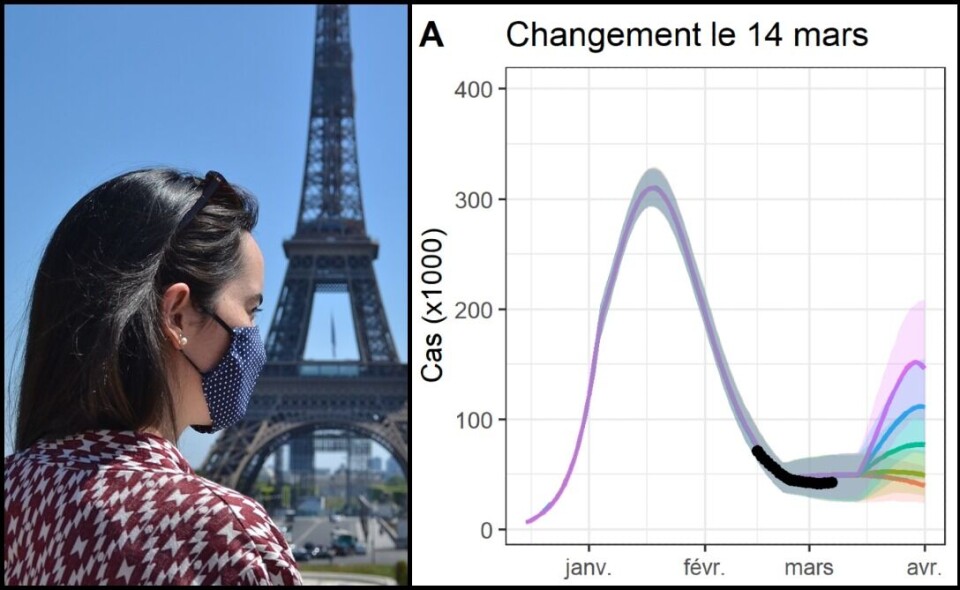-
White storks make strong return in France via nest ‘platforms’ and clipped wings
The Ligue pour la Protection des Oiseaux shares the conservation challenges in saving these birds from extinction
-
Hosting scheme in south-west France lets newcomers sample lifestyle
Households in nine Dordogne communes volunteer under Mes Nouveaux Voisins scheme
-
French boulangeries demand right for staff to work on May 1 so they can open
Artisan bakery owners can work but employees cannot, while certain industrial bakeries are allowed to remain open with workers
Five Covid scenarios from France’s Pasteur Institute as rules ease
The research centre looks at how the end of the vaccine pass will affect case rates. The worst-case scenario shows around 150,000 new cases a day and the best 50,000

France’s renowned Pasteur Institute has mapped out five possible scenarios for how Covid case rates will progress after further rules are relaxed on Monday March 14.
In all five, the peak will not be as high as it was in January and February, when over 350,000 cases were being reported each day. But in the worst-case, case rates could climb to around 150,000 per day.
The vaccine pass system, requiring all over 16s to show proof of being fully vaccinated or having recovered from Covid to enter most public places, will end on March 14. It will also not be necessary from that date to wear a mask in indoor public places (except on public transport, hospitals and a few other places).
Read more:Mask wearing, vaccine pass… new rules for France from March 14
Read more:France Covid: doctors call for caution ahead of rule relaxations
The Pasteur Institute’s report, published yesterday (March 10), charts out what case rates could look like if the transmission rate after March 14 is at 40%, 50%, 75%, 100% or 130% of the rates in January and February.
It also looks at what could happen if people in France, anticipating the relaxation of measures, start to increase their contact with others earlier. To account for this, the report also maps out scenarios where case rates change from March 7.
Simon Cauchemez, one of the authors of the report, said:
“We hypothesised that the French would increase their contact with others on March 1, leading to a plateau of cases in early March.
“The plateau was actually observed a little earlier and is consistent with an increase in contacts on February 22.
“So, we have explored scenarios where the relaxation of measures leads to people interacting with each other further from March 7 and 14. In all scenarios, the peak of cases remains much lower than the January peak.”

In the worst-case scenario, represented in purple, transmission rates are 130% higher than they were in January and February. This could lead to around 150,000 new Covid cases each day, according to the Institute’s models.
In the best-case scenario, represented in red, case rates are likely to plateau at around their current levels, 50,000 per day, before starting to drop off in April.
The Institute Pasteur explains that in its modelling, it hypothesised that people infected by the Omicron variant would not be reinfected again before April (the end of the timescale they looked at).
This would explain why even if transmission rates are 130% the levels in January and February, it is predicting fewer cases.
The report explains that these scenarios are based on previous trends observed during the pandemic, but that they are still incomplete and uncertain, with the pandemic being difficult to anticipate accurately.
For example, it did not take into account the fact that people’s immunisation to Covid, granted by either vaccination or infection, could wane over time. It also does not consider the effects of the weather, with Covid usually spreading less in warmer months.
The scenarios also only look at general case rates, without looking at how it may differ between demographics, or looking at hospitalisation rates or intensive care unit admissions.
The report did not give an indication of how increased case rates would affect hospital rates, ICU admissions or deaths.
Read more:Covid France cases stop falling but no reason necessarily for concern
The Covid situation in France currently
France is averaging 54,372 new cases each day, based on figures from the past seven days. This is 1% more than the previous week, figures from Covidtracker.fr show.
1,928 people are in the ICU due to Covid, 14% fewer than last week, while 21,287 are in hospital with Covid, 8% fewer than last week.
On average, 126 people are dying of Covid in hospital each day, 19% fewer than last week.
France's health minister Olivier Véran said today (March 11) that France must be "extremely careful" about rising Covid cases.
"We are currently seeing a rebound in France, in the countries around us, meaning Covid cases are no longer falling, but rising," he said.
"On the other hand, the hospital rates continue to fall, but the rate of decline has started to slow down.
He said that this development will not impact the plans to relax Covid measures on Monday, March 14.
Related articles
Coronavirus: Daily updates on the situation in France
France confirms 10 cases of hybrid Covid strain ‘Deltacron’
























